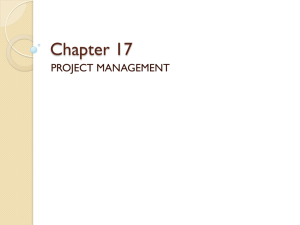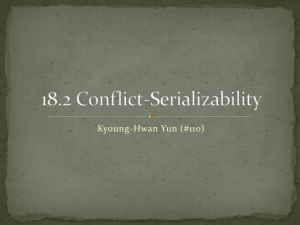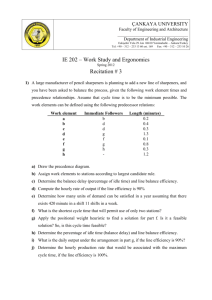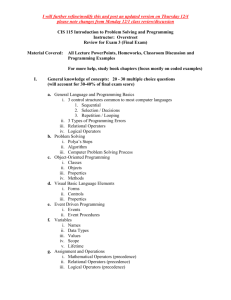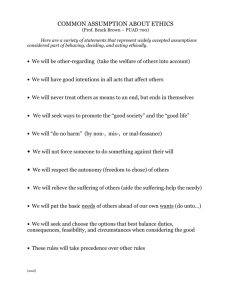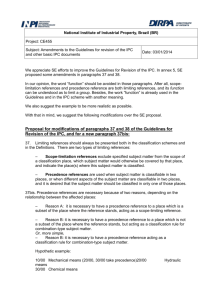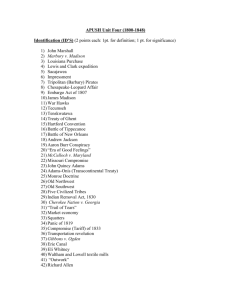Incremental Maintenance of Double Precedence Graphs: A Constraint-Based Approach
advertisement
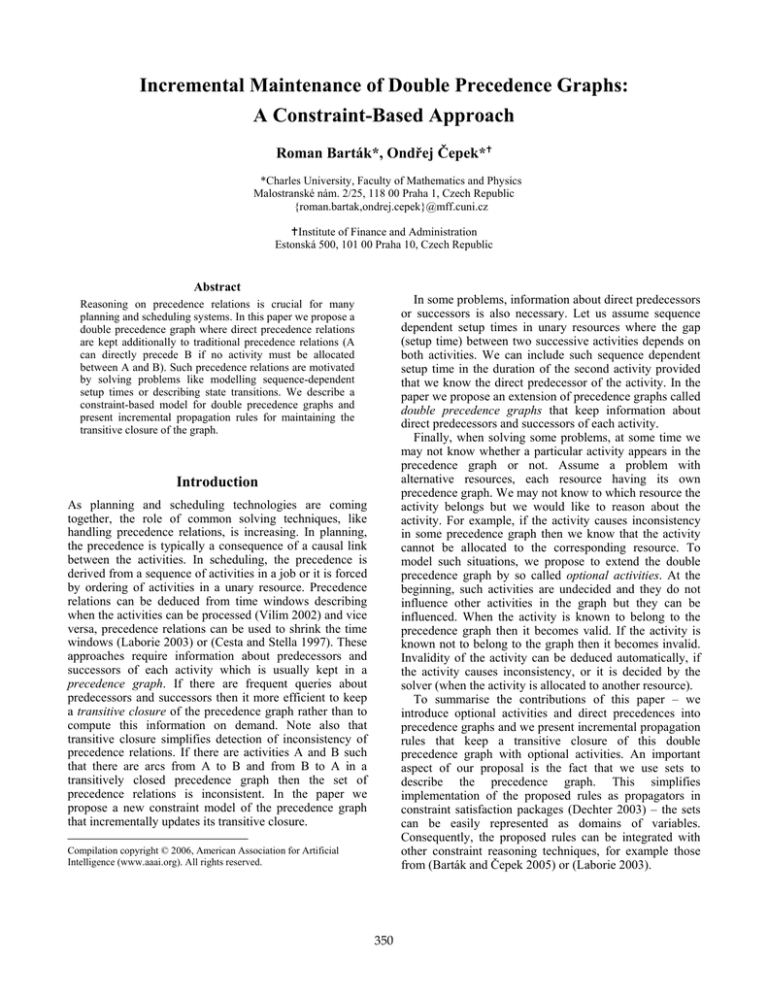
Incremental Maintenance of Double Precedence Graphs:
A Constraint-Based Approach
Roman Barták*, Ondřej Čepek*g
*Charles University, Faculty of Mathematics and Physics
Malostranské nám. 2/25, 118 00 Praha 1, Czech Republic
{roman.bartak,ondrej.cepek}@mff.cuni.cz
gInstitute of Finance and Administration
Estonská 500, 101 00 Praha 10, Czech Republic
Abstract
In some problems, information about direct predecessors
or successors is also necessary. Let us assume sequence
dependent setup times in unary resources where the gap
(setup time) between two successive activities depends on
both activities. We can include such sequence dependent
setup time in the duration of the second activity provided
that we know the direct predecessor of the activity. In the
paper we propose an extension of precedence graphs called
double precedence graphs that keep information about
direct predecessors and successors of each activity.
Finally, when solving some problems, at some time we
may not know whether a particular activity appears in the
precedence graph or not. Assume a problem with
alternative resources, each resource having its own
precedence graph. We may not know to which resource the
activity belongs but we would like to reason about the
activity. For example, if the activity causes inconsistency
in some precedence graph then we know that the activity
cannot be allocated to the corresponding resource. To
model such situations, we propose to extend the double
precedence graph by so called optional activities. At the
beginning, such activities are undecided and they do not
influence other activities in the graph but they can be
influenced. When the activity is known to belong to the
precedence graph then it becomes valid. If the activity is
known not to belong to the graph then it becomes invalid.
Invalidity of the activity can be deduced automatically, if
the activity causes inconsistency, or it is decided by the
solver (when the activity is allocated to another resource).
To summarise the contributions of this paper – we
introduce optional activities and direct precedences into
precedence graphs and we present incremental propagation
rules that keep a transitive closure of this double
precedence graph with optional activities. An important
aspect of our proposal is the fact that we use sets to
describe the precedence graph. This simplifies
implementation of the proposed rules as propagators in
constraint satisfaction packages (Dechter 2003) – the sets
can be easily represented as domains of variables.
Consequently, the proposed rules can be integrated with
other constraint reasoning techniques, for example those
from (Barták and Čepek 2005) or (Laborie 2003).
Reasoning on precedence relations is crucial for many
planning and scheduling systems. In this paper we propose a
double precedence graph where direct precedence relations
are kept additionally to traditional precedence relations (A
can directly precede B if no activity must be allocated
between A and B). Such precedence relations are motivated
by solving problems like modelling sequence-dependent
setup times or describing state transitions. We describe a
constraint-based model for double precedence graphs and
present incremental propagation rules for maintaining the
transitive closure of the graph.
Introduction
As planning and scheduling technologies are coming
together, the role of common solving techniques, like
handling precedence relations, is increasing. In planning,
the precedence is typically a consequence of a causal link
between the activities. In scheduling, the precedence is
derived from a sequence of activities in a job or it is forced
by ordering of activities in a unary resource. Precedence
relations can be deduced from time windows describing
when the activities can be processed (Vilím 2002) and vice
versa, precedence relations can be used to shrink the time
windows (Laborie 2003) or (Cesta and Stella 1997). These
approaches require information about predecessors and
successors of each activity which is usually kept in a
precedence graph. If there are frequent queries about
predecessors and successors then it more efficient to keep
a transitive closure of the precedence graph rather than to
compute this information on demand. Note also that
transitive closure simplifies detection of inconsistency of
precedence relations. If there are activities A and B such
that there are arcs from A to B and from B to A in a
transitively closed precedence graph then the set of
precedence relations is inconsistent. In the paper we
propose a new constraint model of the precedence graph
that incrementally updates its transitive closure.
Compilation copyright © 2006, American Association for Artificial
Intelligence (www.aaai.org). All rights reserved.
350
a unique number from the set 1,..,n, where n is the number
of activities. For each activity we use a 0/1 variable Valid
indicating whether the activity is valid (1) or invalid (0). If
the activity is undecided then the domain of Valid is {0,1}.
The precedence graph is encoded in two sets attached to
each activity. CanBeBefore is a set of indices of activities
that can be before a given activity. CanBeAfter is a set of
indices of activities that can be after the activity. If we add
an arc between A and B (A«B) then we remove the index
of A from CanBeAfter(B) and the index of B from
CanBeBefore(A). For simplicity reasons we will write A
instead of the index of A. Because adding new arcs is
realised by removing values from above two sets, these
sets can be easily implemented as finite domains of two
variables (in a CSP it is only possible to remove values
from domains as reasoning proceeds). To simplify
description of the propagation rules we also define for
every activity A the following sets:
Double Precedence Graphs
The precedence relations among activities define a
precedence graph that is an acyclic directed graph where
nodes correspond to activities and there is an arc from A to
B if A«B (A must be before B).
Definition 1: We say that a precedence graph G is
transitively closed if for any path from A to B in G there is
also an arc from A to B in G.
Defining the transitive closure is more complicated when
optional activities are assumed. Let A«B and B«C and B
be undecided. In such a case, it is not possible to deduce
that A«C because if B is removed – becomes invalid – then
the path from A to C is lost. Therefore, we need to define
the transitive closure more carefully.
Definition 2: We say that a precedence graph G with
optional activities is transitively closed if for any two arcs
A to B and B to C such that B is a valid activity and A and
C are either valid or undecided activities there is also an
arc A to C in G.
MustBeAfter(A) = CanBeAfter(A) \ CanBeBefore(A)
MustBeBefore(A) = CanBeBefore(A) \ CanBeAfter(A)
Unknown(A) = CanBeBefore(A) ∩ CanBeAfter(A).
MustBeAfter(A) and MustBeBefore(A) are sets of those
activities that must be after and before the given activity A
respectively. Unknown(A) is a set of activities that are not
yet known to be before or after activity A.
To model direct precedence relations we add two sets to
each activity: CanBeRightBefore and CanBeRightAfter
containing initially values 1,..,n with the same meaning as
above. The contents of these two new sets are defined
according to Definition 3 as follows:
It is easy to prove by induction of the path length that if
there is a path from A to B such that A and B are either
valid or undecided and all inner nodes in the path are valid
then there is also an arc from A to B in a transitively closed
graph. Hence, if no optional activity is used (all activities
are valid) then Definition 2 is identical to Definition 1.
As we argued in Introduction, for some problems it is
important to keep also the direct precedence relations
between the activities.
A∈CanBeRightBefore(B) ≡
A∈CanBeBefore(B) ∧
¬∃C valid(C)=1 ∧ C∈MustBeAfter(A) ∧ C∈MustBeBefore(B)
A∈CanBeRightAfter(B) ≡
A∈CanBeAfter(B) ∧
¬∃C valid(C) =1 ∧ C∈MustBeBefore(A) ∧ C∈MustBeAfter(B)
Definition 3: We say that A can directly precede B if both
A and B are either valid or undecided activities, B is not
before A (¬B«A) and there is no valid activity C such that
A«C and C«B (the relation « is from the transitive closure
of the precedence graph with optional activities).
The relation of direct precedence introduces a new type of
arc, say «d, in the precedence graph and hence we are
speaking about the double precedence graph. There is one
significant difference between the arcs of type « and the
arcs of type «d. While the arcs « are added into the graph as
problem solving proceeds, the arcs «d are typically
removed from the graph. Moreover, if parallel activities
are not assumed then in the solution there is exactly one
arc of type «d going into each valid activity (with the
exception of the very first activity in the schedule) and one
arc of type «d going from each valid activity (with the
exception of the very last activity in the schedule).
Clearly, A «d B ⇔ A ∈ CanBeRightBefore(B) ⇔
B ∈ CanBeRightAfter(A). Note that if the transitive
closure of the precedence graph is kept then it is easy to
maintain the above two sets. In particular, each time an
activity is removed from CanBeBefore, the same activity is
removed from CanBeRightBefore (similarly for
CanBeRightAfter). Moreover, if an arc A«B is added to reestablish the transitive closure (because there exists a valid
activity C such that A«C and C«B) then B is removed from
CanBeRightAfter(A) and A is removed from
CanBeRightBefore(B).
Constraint Model
Propagation Rules
As mentioned in the Introduction we propose to realise a
reasoning on precedence relations using a constraint
satisfaction technology. Our model achieves global
consistency and provides full information about
precedence relations and direct precedence relations to all
other constraints. This model also fully integrates
reasoning on optional activities. We index each activity by
Usually, CSPs are solved by removing inconsistent values
from the domains, this is called domain filtering. Our
propagation rules do exactly the same job – inconsistent
values are removed from the above described sets.
Moreover, we guarantee global consistency, that is, every
value that remains in the domain after filtering can be part
of some solution (proofs are omitted due to space limits).
351
We initiate the double precedence graph in the following
way. First, the variables CanBeBefore(A), CanBeAfter(A),
CanBeRightBefore(A),
CanBeRightAfter(A),
and
Valid(A) with their domains are created for every activity
A. Then the known precedence relations are added by
pruning the domains of CanBeBefore(A), CanBeAfter(A),
CanBeRightBefore(A), and CanBeRightAfter(A) as
described above. Note, that because all activities are still
undecided at this stage, domain change is not propagated
to other variables. Finally, the Valid(A) variable for every
valid activity A is set to 1 (activities that are known to be
invalid from the beginning may be omitted from the graph
or their Valid variables are set to 0).
Propagation rule /1/ is invoked when the validity status
of the activity becomes known. “Valid(A) is instantiated”
is its trigger. The part after is a propagator describing
pruning of domains. “exit” means that the constraint
represented by the propagation rule is entailed so the
propagator is not further invoked (its invocation does not
cause further domain pruning). We will use the same
notation in all rules.
keeping the (generalised) transitive closure according to
Definition 2 (we omit the proof due to space limits).
However, in some situations arcs may be added to the
precedence graph during the solving procedure, either by
the user, by the scheduler/planner, or by other filtering
algorithms like the one described in (Barták and Čepek
2005). The following rule updates the double precedence
graph to keep transitive closure when an arc of type « is
added to the double precedence graph.
A«B is added
/2/
if A∈MustBeBefore(B) then exit
CanBeAfter(B) ← CanBeAfter(B) \ {A}
CanBeRightAfter(B) ← CanBeRightAfter(B) \ {A}
CanBeBefore(A) ← CanBeBefore(A) \ {B}
CanBeRightBefore(A) ← CanBeRightBefore(A) \ {B}
if A∉CanBeBefore(B) then // break the cycle
enqueue_for_propagation(Valid(A)=0 ∨ Valid(B)=0)
else
if Valid(A)=1 then // transitive closure
for each C∈MustBeBefore(A) do
CanBeRightAfter(C) ← CanBeRightAfter(C) \ {B}
CanBeRightBefore(B) ← CanBeRightBefore(B) \ {C}
if C∉MustBeBefore(B) then
// new precedence
enqueue_for_propagation(add C«B)
if Valid(B)=1 then // transitive closure
for each C∈MustBeAfter(B) do
CanBeRightAfter(A) ← CanBeRightAfter(A) \ {C}
CanBeRightBefore(C) ← CanBeRightBefore(C) \ {A}
if C∉MustBeAfter(A) then
// new precedence
enqueue_for_propagation(add A«C)
exit
Valid(A) is instantiated
/1/
if Valid(A) = 0 then
for each B do
// disconnect A from B
CanBeBefore(B) ← CanBeBefore(B) \ {A}
CanBeAfter(B) ← CanBeAfter(B) \ {A}
CanBeRightBefore(B) ← CanBeRightBefore(B) \ {A}
CanBeRightAfter(B) ← CanBeRightAfter(B) \ {A}
else
// Valid(A)=1
for each B∈MustBeBefore(A) do
for each C∈MustBeAfter(A) do
CanBeRightAfter(B) ← CanBeRightAfter(B) \ {C}
CanBeRightBefore(C) ← CanBeRightBefore(C) \ {B}
if C∉MustBeAfter(B) then // new precedence B«C
CanBeAfter(C) ← CanBeAfter(C) \ {B}
CanBeBefore(B) ← CanBeBefore(B) \ {C}
CanBeRightAfter(C) ← CanBeRightAfter(C) \ {B}
CanBeRightBefore(B) ← CanBeRightBefore(B) \ {C}
if C∉CanBeAfter(B) then // break the cycle
enqueue_for_propagation(Valid(B)=0 ∨ Valid(C)=0)
exit
The rule /2/ does the following. If a new arc A«B is added
then the sets CanBeBefore(A), CanBeAfter(B),
CanBeRightBefore(A), and CanBeRightAfter(B) are
updated. If a cycle is detected then the cycle is broken in
the same way as in rule /1/. The rest of the propagation
rule ensures that if one of endpoints of the added arc is
valid then other arcs are added recursively to keep a
transitive closure. If such an arc C«B is added then the arc
C«dB between the same nodes is removed because there
cannot be a direct precedence between B and C (there is A
between B and C). Note finally that the propagators for
new arcs are evoked after the propagator of the current rule
finishes. Hence, new arcs are enqueued for later
propagation. It may happen that the same arc is present
more times in the propagation queue. To prevent running
the propagation rule more times for the same arc, we check
at the beginning whether the rule has already been invoked
and in such a case, the propagator is stopped immediately.
Again, it is possible to prove that if the precedence graph
G is transitively closed and arc A«B is added to G then the
propagation rule /2/ updates the precedence graph G to be
transitively closed again. The worst-case time complexity
of the propagation rule /2/ (adding a new arc) including all
recursive calls to rules /1/ and /2/ is O(n3), where n is a
number of activities.
Observation: Note that rule /1/ maintains symmetry for all
valid and undecided activities because the domains are
pruned symmetrically in pairs. This symmetry can be
defined as follows: if Valid(B)≠0 and Valid(C)≠0 then
B∈CanBeBefore(C) if and only if C∈CanBeAfter(B). This
moreover implies that B∈MustBeBefore(C) if and only if
C∈MustBeAfter(B). Finally, the same deduction implies
that
B∈CanBeRightBefore(C)
if and only if
C∈CanBeRightAfter(B).
The worst-case time complexity of the propagation rule
/1/ (instantiation of the Valid variable) including all
possible recursive calls is O(n2), where n is a number of
activities. It is possible to prove that if the entire
precedence graph is known in advance (no arcs are added
during the solving procedure), then rule /1/ is sufficient for
352
Explicit Direct Precedence Relations. So far, we
assumed that the direct precedence relations are derived
only from existing “normal” precedence relations. It is
possible to prove that in such a case the propagation rules
/1/ and /2/ maintain correctly the sets CanBeRightBefore
and CanBeRightAfter and this propagation is complete,
that is, if A ∈ CanBeRightBefore(B) then there exists a
scenario in which A is scheduled right before B. In some
problems there may be also explicit direct precedence
relations. For example, if there is not enough time for setup
between A and B then we can deduce that A cannot
directly precede B (¬ A «d B). We will now present a rule
that propagates information about such explicit direct
precedence relations.
When a direct precedence A «d B is forbidden then A is
deleted from the set CanBeRightBefore(B) and B is
deleted from the set CanBeRightAfter(A). According to
Definition 3 we can deduce that either A is after B (B « A)
or there must be a valid activity C between A and B.
Actually, there must be some C before B and right after A
and some D after A and right before B (C=D may happen):
CanBeRightAfter(A) ∩ CanBeBefore(B)=∅ ⇒ B«A
CanBeAfter(A) ∩ CanBeRightBefore(B)=∅ ⇒ B«A.
The above implications can be used to deduce that B must
be before A, if there is no activity that may appear between
A and B. Vice versa, if A must be before B and both A and
B are valid then we can actively look for activities between
A and B. The following rule realizes this deduction.
removes the direct precedence relation from the graph and
activates rule /3/.
A«dB is deleted
CanBeRightAfter(A) ← CanBeRightAfter(A) \ {B}
CanBeRightBefore(B) ← CanBeRightBefore(B) \ {A}
activate rule /3/ for A and B
exit
/4/
There are several differences between rules /1/ and /2/ and
rule /3/. The rules /1/ and /2/ are called only once and they
deduce all changes in the double precedence graph. The
rule /3/ can be evoked more times until it ensures validity
of Definition 3, that is, either B is after A or there is a valid
activity C between A and B. The open question is whether
this rule deduces all changes in the precedence graph or
whether the propagation can be further strengthened.
Conclusions
The paper presents a constraint-based approach to model
double precedence graph where both standard and direct
precedence relations are represented and optional activities
are assumed. We proposed incremental propagation rules
that keep a transitive closure of the precedence graph and
achieve global consistency. We also proposed a
propagation rule for explicit direct precedences that are
useful to model problems like sequence-dependent setup
times. Last but not least, the proposed model can be easily
integrated with other constraint reasoning techniques like
reasoning on time windows. Hence, we believe that this
approach can accelerate exploitation of constraint
satisfaction technology in solving problems that include
both planning and scheduling components.
CanBeRightAfter(A) or CanBeAfter(A) or CanBeBefore(A) or
CanBeRightBefore(B) or CanBeBefore(B) or CanBeAfter(B) is
changed, or Valid(A) or Valid(B) is instantiated
/3/
if Valid(A)=0 or Valid(B)=0 or A∈MustBeAfter(B) then exit
if CanBeRightAfter(A)∩CanBeBefore(B)=∅
or CanBeAfter(A)∩CanBeRightBefore(B)=∅ then
enqueue_for_propagation(add B«A)
exit
if A∈MustBeBefore(B) & Valid(A)=1 & Valid(B)=1 then
if {C}=CanBeRightAfter(A)∩CanBeBefore(B) then
// C is the only possible direct successor of A
enqueue_for_propagation(add A«C)
enqueue_for_propagation(add C«B)
Valid(C) = 1
exit
if {C}= CanBeAfter(A)∩CanBeRightBefore(B) then
// C is the only possible direct predecessor of B
enqueue_for_propagation(add A«C)
enqueue_for_propagation(add C«B)
Valid(C) = 1
exit
References
Barták, R. and Čepek, O. 2005. Incremental Propagation
Rules for A Precedence Graph with Optional Activities
and Time Windows. In Proceedings of The 2nd
Multidisciplinary International Conference on Scheduling:
Theory and Applications (MISTA 2005), New York.
Cesta, A. and Stella, C. 1997. A Time and Resource
Problem for Planning Architectures, Recent Advances in AI
Planning (ECP’97), LNAI 1348, Springer Verlag, 117129.
Dechter, R.
Kaufmann.
2003.
Constraint
Processing,
Morgan
Laborie, P. 2003. Algorithms for propagating resource
constraints in AI planning and scheduling: Existing
approaches and new results, Artificial Intelligence, 143,
151-188.
The propagation rule /3/ is activated only when a direct
precedence relation is discarded from the double
precedence graph due to “external” reasons. Specifically,
this rule is not active if sets CanBeRightBefore and
CanBeRightAfter are changed within rules /1/ and /2/. This
is because, rules /1/ and /2/ remove the direct precedence
due to Definition 3 so no further propagation can be
achieved by rule /3/. The following propagation rule /4/
Vilím, P. 2002. Batch Processing with Sequence
Dependent Setup Times: New Results. In Proceedings of
the 4th Workshop of Constraint Programming for Decision
and Control, CPDC'02. Gliwice, Poland.
353
